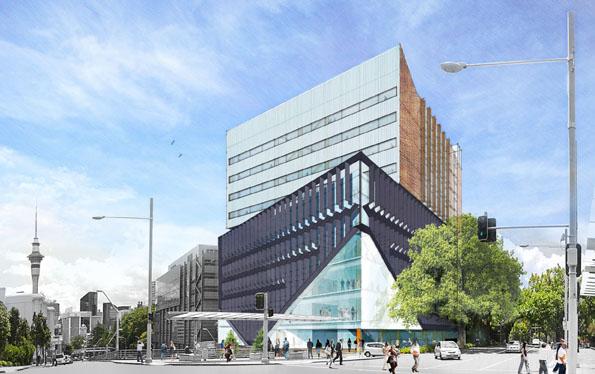The University of Auckland is to invest more than $200 million in a major redevelopment that will provide state of the art research and teaching facilities for its Faculty of Science and a new entranceway to the University. “The Science Centre project will enhance the faculty’s already significant contributions to research and economic development in New Zealand,” says University of Auckland Vice-Chancellor Professor Stuart McCutcheon, noting that it coincides with the Government’s drive to lift science and innovation outcomes. “We share the Government’s commitment to economic growth through innovation and believe this investment will support teaching, research and the vital interface with businesses which will collectively underpin our goals for the future,” he says.
The project is on a scale comparable to the construction of the Owen G Glenn Building which houses the Business School, the upgrade of the Faculty of Medical and Health Science’s Grafton Campus and the recently announced redevelopment of the Faculty of Engineering. Collectively, the University’s concurrent new investments in science and engineering facilities exceed $400 million – one of the most significant investments in the New Zealand science and innovation sector. The Science Centre project will see the south podium of the building on the corner of Symonds and Wellesley Streets (known as Building 301 or the Chemistry Building) demolished and a new tower erected in its place. The new building will comprise eleven stories and a basement with a total floor area of 23,500 m2. Much of the adjacent tower building will also be refurbished, giving a total of almost 38,000m2 of new or refurbished space. The work follows the refurbishment of the science building on the corner of Wellesley and Princes Streets (known as Building 303 or the Mathematics and Physics Building).
The Faculty of Science is the highest-ranked in New Zealand, and its research activity and staff and student bodies are forecast to grow substantially over the next ten years. The redevelopment will accommodate most of this growth, and provide modern research, teaching and study environments. The project will bring together scientific disciplines previously dispersed across the campus, increasing the opportunities for cross-disciplinary collaboration. The School of Environment, Institute of Earth Science and Engineering, National eScience Infrastructure, Department of Psychology and School of Chemical Sciences will move into the new building. They will join colleagues from the Departments of Physics, Mathematics, Statistics and Computer Science accommodated in buildings in the same complex.
The project will also help the University support the development of the high-value manufacturing sector. The complex will house a wide array of high-technology equipment including micro-fabrication facilities, mass spectrometry instruments, nuclear magnetic resonance equipment, high energy lasers, and photonics and acoustic suites. Designed by Architectus, the new building will provide a welcoming entranceway for students and the public on one of the University’s busiest street corners. From open public spaces on the ground floor the building will transition into formal teaching spaces and then specialised research areas on the upper levels. It is designed to have a logical flow and encourage interaction between disciplines. Students will benefit from large communal spaces, centralised student services, informal areas with access to wireless internet and drop in study spaces.
“This redevelopment is part of a ten-year campus renewal plan valued in excess of $1 billion that is bringing our facilities up to the highest possible standard. It demonstrates our commitment to science and reflects the importance of science and innovation to New Zealand’s future,” says Professor McCutcheon. “The Faculty has an important role to play in the sustainable development of the nation,” says Dean Professor Grant Guilford. “From our location in the country’s commercial capital we are well-placed to support not only New Zealand’s economic development but to help address key challenges to the environment, biodiversity and societal health and wellbeing. We need to invest in the best possible facilities to ensure that our talented staff and students have an appropriate platform to continue to advance the sciences while further enhancing their contributions to our communities.”
The redevelopment project was approved by the University Council on Monday 26 June. Design work is already underway, and construction is due to begin in 2013 and be completed in 2017.



